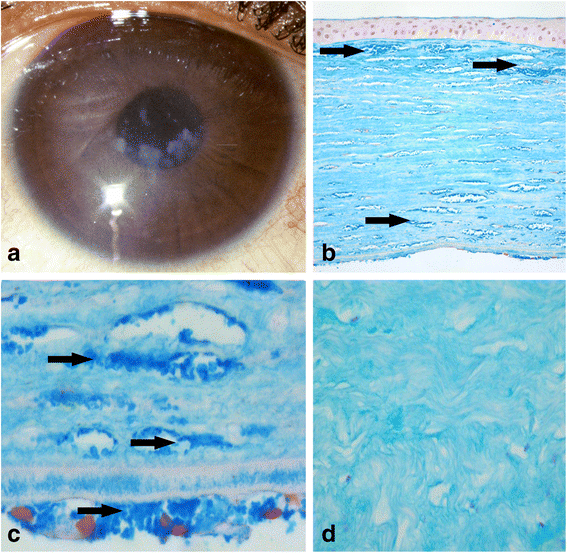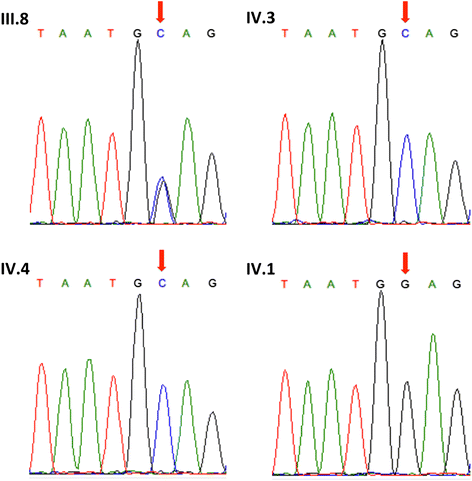Novel mutation in the CHST6 gene causes macular corneal dystrophy in a black South African family
- PMID: 27439461
- PMCID: PMC4955246
- DOI: 10.1186/s12881-016-0308-0
Novel mutation in the CHST6 gene causes macular corneal dystrophy in a black South African family
Abstract
Background: Macular corneal dystrophy (MCD) is a rare autosomal recessive disorder that is characterized by progressive corneal opacity that starts in early childhood and ultimately progresses to blindness in early adulthood. The aim of this study was to identify the cause of MCD in a black South African family with two affected sisters.
Methods: A multigenerational South African Sotho-speaking family with type I MCD was studied using whole exome sequencing. Variant filtering to identify the MCD-causal mutation included the disease inheritance pattern, variant minor allele frequency and potential functional impact.
Results: Ophthalmologic evaluation of the cases revealed a typical MCD phenotype and none of the other family members were affected. An average of 127 713 variants per individual was identified following exome sequencing and approximately 1.2 % were not present in any of the investigated public databases. Variant filtering identified a homozygous E71Q mutation in CHST6, a known MCD-causing gene encoding corneal N-acetyl glucosamine-6-O-sulfotransferase. This E71Q mutation results in a non-conservative amino acid change in a highly conserved functional domain of the human CHST6 that is essential for enzyme activity.
Conclusion: We identified a novel E71Q mutation in CHST6 as the MCD-causal mutation in a black South African family with type I MCD. This is the first description of MCD in a black Sub-Saharan African family and therefore contributes valuable insights into the genetic aetiology of this disease, while improving genetic counselling for this and potentially other MCD families.
Keywords: African; CHST6; Macular corneal dystrophy; Whole exome sequencing.
Figures




Similar articles
-
Identification of novel mutations in the carbohydrate sulfotransferase gene (CHST6) causing macular corneal dystrophy.Invest Ophthalmol Vis Sci. 2002 Feb;43(2):377-82. Invest Ophthalmol Vis Sci. 2002. PMID: 11818380
-
Novel mutations in the CHST6 gene causing macular corneal dystrophy.Clin Genet. 2004 Feb;65(2):120-5. doi: 10.1111/j.0009-9163.2004.00191.x. Clin Genet. 2004. PMID: 14984470
-
Mutations in corneal carbohydrate sulfotransferase 6 gene (CHST6) cause macular corneal dystrophy in Iceland.Mol Vis. 2000 Dec 13;6:261-4. Mol Vis. 2000. PMID: 11139648
-
[Macular corneal dystrophy--clinical state, histopathologic, immunohistochemical examinations and genetical dependence].Klin Oczna. 2004;106(6):802-5. Klin Oczna. 2004. PMID: 15787187 Review. Polish.
-
Macular Corneal Dystrophy: An Updated Review.Curr Eye Res. 2021 Jun;46(6):765-770. doi: 10.1080/02713683.2020.1849727. Epub 2020 Nov 29. Curr Eye Res. 2021. PMID: 33171054 Review.
Cited by
-
The Next Generation Scientist program: capacity-building for future scientific leaders in low- and middle-income countries.BMC Med Educ. 2018 Oct 10;18(1):233. doi: 10.1186/s12909-018-1331-y. BMC Med Educ. 2018. PMID: 30305069 Free PMC article.
-
The Genetics Journey: A Case Report of a Genetic Diagnosis Made 30 Years Later.J Genet Couns. 2017 Oct;26(5):894-901. doi: 10.1007/s10897-017-0119-2. Epub 2017 Jun 13. J Genet Couns. 2017. PMID: 28612151
-
Reconstruction of the Carbohydrate 6-O Sulfotransferase Gene Family Evolution in Vertebrates Reveals Novel Member, CHST16, Lost in Amniotes.Genome Biol Evol. 2020 Jul 1;12(7):993-1012. doi: 10.1093/gbe/evz274. Genome Biol Evol. 2020. PMID: 32652010 Free PMC article.
-
Novel compound heterozygous mutations in the CHST6 gene cause macular corneal dystrophy in a Han Chinese family.Ann Transl Med. 2021 Apr;9(8):622. doi: 10.21037/atm-20-7178. Ann Transl Med. 2021. PMID: 33987320 Free PMC article.
-
A comprehensive evaluation of 181 reported CHST6 variants in patients with macular corneal dystrophy.Aging (Albany NY). 2019 Feb 4;11(3):1019-1029. doi: 10.18632/aging.101807. Aging (Albany NY). 2019. PMID: 30716718 Free PMC article.
References
-
- Klintworth GK, Smith CF, Bowling BL. CHST6 mutations in North American subjects with macular corneal dystrophy : a comprehensive molecular genetic review. Mol Vis. 2006;12:159–176. - PubMed
Publication types
MeSH terms
Substances
Supplementary concepts
Grants and funding
LinkOut - more resources
Full Text Sources
Other Literature Sources

